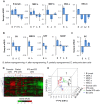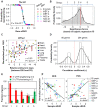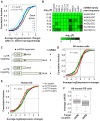Reprogramming of 3' untranslated regions of mRNAs by alternative polyadenylation in generation of pluripotent stem cells from different cell types
- PMID: 20037631
- PMCID: PMC2791866
- DOI: 10.1371/journal.pone.0008419
Reprogramming of 3' untranslated regions of mRNAs by alternative polyadenylation in generation of pluripotent stem cells from different cell types
Abstract
Background: The 3' untranslated regions (3'UTRs) of mRNAs contain cis elements involved in post-transcriptional regulation of gene expression. Over half of all mammalian genes contain multiple polyadenylation sites that lead to different 3'UTRs for a gene. Studies have shown that the alternative polyadenylation (APA) pattern varies across tissues, and is dynamically regulated in proliferating or differentiating cells. Generation of induced pluripotent stem (iPS) cells, in which differentiated cells are reprogrammed to an embryonic stem (ES) cell-like state, has been intensively studied in recent years. However, it is not known how 3'UTRs are regulated during cell reprogramming.
Methods/main findings: Using a computational method that robustly examines APA across DNA microarray data sets, we analyzed 3'UTR dynamics in generation of iPS cells from different cell types. We found that 3'UTRs shorten during reprogramming of somatic cells, the extent of which depends on the type of source cell. By contrast, reprogramming of spermatogonial cells involves 3'UTR lengthening. The alternative polyadenylation sites that are highly responsive to change of cell state in generation of iPS cells are also highly regulated during embryonic development in opposite directions. Compared with other sites, they are more conserved, can lead to longer alternative 3'UTRs, and are associated with more cis elements for polyadenylation. Consistently, reprogramming of somatic cells and germ cells involves significant upregulation and downregulation, respectively, of mRNAs encoding polyadenylation factors, and RNA processing is one of the most significantly regulated biological processes during cell reprogramming. Furthermore, genes containing target sites of ES cell-specific microRNAs (miRNAs) in different portions of 3'UTR are distinctively regulated during cell reprogramming, suggesting impact of APA on miRNA targeting.
Conclusions/significance: Taken together, these findings indicate that reprogramming of 3'UTRs by APA, which result from regulation of both general polyadenylation activity and cell type-specific factors and can reset post-transcriptional gene regulatory programs in the cell, is an integral part of iPS cell generation, and the APA pattern can be a good biomarker for cell type and state, useful for sample classification. The results also suggest that perturbation of the mRNA polyadenylation machinery or RNA processing activity may facilitate generation of iPS cells.
Conflict of interest statement
Figures







References
-
- Rossant J. Stem cells and lineage development in the mammalian blastocyst. Reprod Fertil Dev. 2007;19:111–118. - PubMed
-
- Takahashi K, Yamanaka S. Induction of pluripotent stem cells from mouse embryonic and adult fibroblast cultures by defined factors. Cell. 2006;126:663–676. - PubMed
-
- Lowry WE, Plath K. The many ways to make an iPS cell. Nat Biotechnol. 2008;26:1246–1248. - PubMed
Publication types
MeSH terms
Substances
Grants and funding
LinkOut - more resources
Full Text Sources
Other Literature Sources

